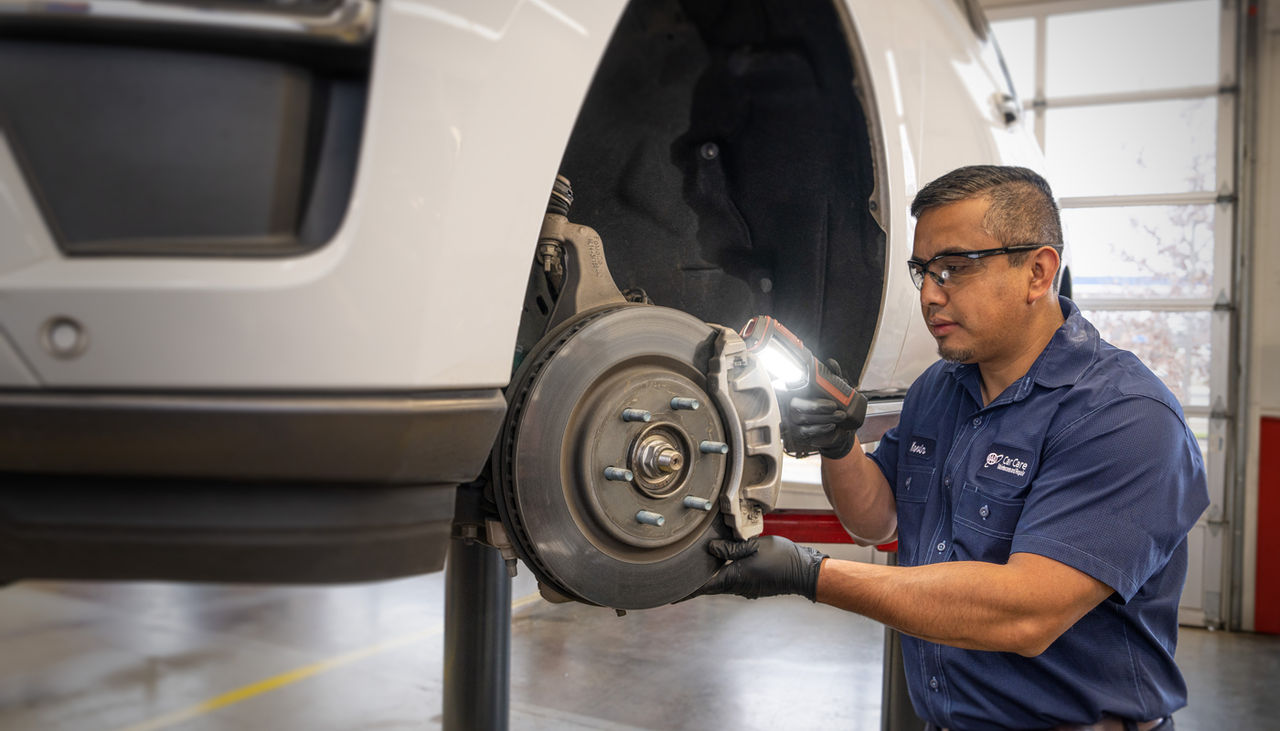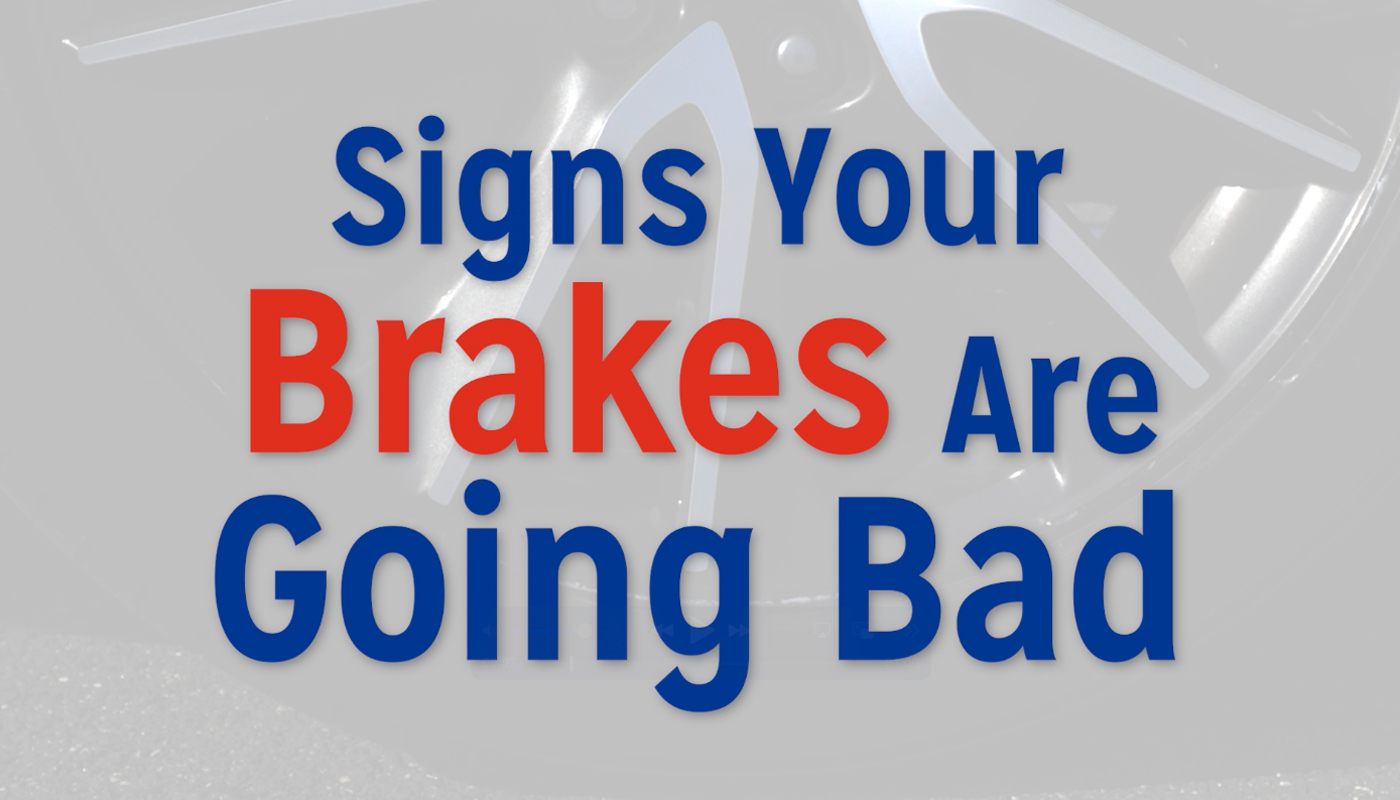To ensure you receive the best service possible,
please enter your zip code below:

In this guide, you’ll learn:

Picture yourself driving down the interstate at 70 mph with your exit just ahead. As you glide onto the off-ramp and ease off the accelerator, your car begins to slow on its own. But then you spot a longer-than-expected line of vehicles at the red light. You need to stop—fast. You hit the brake pedal. The car suddenly pulls hard to one side, and a harsh grinding noise fills the cabin. Eyes clenched, heart racing, you keep your foot down.
By some stroke of luck, your vehicle comes to a complete stop—no crash, no injuries. But had your brakes been in a worse condition, the result could’ve been much more serious. Situations like this are a powerful reminder: Dependable brakes aren’t just helpful, they’re essential to your safety.
Understanding how your braking system works, recognizing warning signs and maintaining your brakes properly can help you stay in control when the unexpected happens.

Knowing that your brakes are in the best working condition is important for safety, for protecting yourself, your passengers and other drivers; it reduces the risk of expensive repairs; it is a legal and inspection compliance issue in some states; and it offers peace of mind while on the road.

There will be signs if your brakes are failing. Knowing what they are could help you avoid a serious accident. If you notice any of the following on your drive, it’s important to get your brakes checked ASAP.
Get tips on how to extend the lifespan on your brakes.
Read our guide
If you recognize any of the warning signs of brake trouble—whether it’s strange noises, a spongy pedal or a car that pulls to one side, don’t ignore them. Brake problems rarely fix themselves and tend to get worse (and more expensive) over time.
Act fast: Addressing brake issues as soon as possible helps prevent further damage and ensures your safety on the road. Even if your car still stops, degraded brake performance can fail when you need it most during sudden stops or slippery conditions.
Find a trusted technician: Schedule an inspection with an expert mechanic or visit your nearest AAA-owned Car Care Center or AAA Approved Auto Repair facility. These shops meet high standards for customer service, pricing and technical expertise, so you can feel confident your vehicle is in good hands.
Stay ahead with regular maintenance: Don’t wait for signs of trouble to appear. Regular brake inspections, especially during oil changes or tire rotations, can catch problems early. Following your vehicle’s scheduled maintenance plan helps extend the life of your brake components and ensures everything is working as it should.
Get tips to stay safe while you are driving, whether alone or with your family. Know when to pull your car over.
Read our tips
There are many ways that you can maintain your car brakes to be sure that you are always safe on the road and to prevent expensive brake system repairs. Here are a few of our tips to help you maintain your brakes.
Don’t ride the brakes: Avoid keeping your foot on the brake pedals unnecessarily. This applies even on downhill stretches of roads. This type of driving generates excess heat and wears down pads and rotors.
Maintain a regular inspection schedule: Have your brakes inspected during every oil change or at least every 12,000 miles. Mechanics can spot early signs of wear and uneven pad use before it becomes a serious issue.
Replace brake pads before they’re too worn: Most pads last between 25,000 and 70,000 miles, depending on driving habits. Worn pads can damage rotors and other brake parts.
Check brake fluid regularly: Brake fluid is essential for good brake function. Low or dirty fluid can cause a soft brake pedal or complete brake failure. Replace fluid as recommended by your owner’s manual—typically every 2 to 3 years.
Avoid aggressive driving: Hard and frequent braking, especially at high speeds, wears out brake components faster. Maintain a safe following distance to brake gradually when possible.
Keep tires properly inflated and aligned: Misaligned or underinflated tires can cause uneven brake wear and eventually reduce braking efficiency.

If you start to notice your brakes are failing, the best thing you can do is take them to get serviced. A quick search for “Car Brake Repair Near Me” should provide you with several local options. Be sure to check reviews or even consider taking your vehicle to a nearby AAA-owned Car Care Center or AAA Approved Auto Repair facility, where members receive discounts, and work is guaranteed for two years or 24,000 miles. This isn’t cheap, so make sure the work is high quality, under warranty and fairly priced.
A typical brake pad replacement costs $300-$500 per axle and $1,000-$1,500 for the entire vehicle for pads, calipers and rotors.
When you’re driving, don’t let broken brakes break you! Without a fully functioning brake system, you are endangering yourself and others. By taking the time to learn about your brakes, how to maintain them and how your driving habits can preserve them, you will set yourself and others up for success.
Brake maintenance
You can trust AAA to help. AAA Members receive a free vehicle maintenance inspection upon request with any paid service at a nearby AAA-owned Car Care center or AAA Approved Auto Repair facility, a 36-month/36,000-mile guarantee on repairs at AAA-owned Car Care locations, and a 24-month/24,000-mile warranty at AAA Approved Auto Repair facilities. Members also receive a 10% discount on repair labor (save up to $75).
Common warning signs include grinding noises, longer stopping times, pulling to one side, a soft or spongy pedal and a brake warning light on your dash.
Yes. Worn brake pads can reduce stopping power and lead to damage in other brake components, increasing the risk of an accident or expensive repairs.
Have your brakes checked at least once a year or every 12,000 miles, and any time you hear or feel something unusual.
Avoid hard braking, keep your tires aligned and inflated, check brake fluid regularly, and don’t ride the brakes downhill.
‡Offer valid through 9/02/2025. Offer valid for Classic/Basic Memberships only. Pricing valid at member join only. Offer excludes Motorcycle coverage. Payment of full AAA Membership dues is required upon renewal. Offers, terms, conditions and restrictions apply and are subject to change without notice. Not combinable with any other offer. Offer not valid in FL, GA, MI or PR. A member can add one eligible family member for free for up to one year. Additional Associates are half price. Associate memberships are available to the Primary member’s spouse, one other adult living in the household, and their children living at the same residence or away at school. Associate members must have the same type of membership as their Primary member, with the exception of Motorcycle. Associate membership expires on the renewal date of Primary member.
Upon activation and with proper identification, AAA will provide regular AAA services and full privileges for the new member. Roadside benefits begin three days after payment of dues. Some restrictions apply. Roadside assistance is provided by independent facilities contracted by AAA. Coverage in taxis, limousines and other ride-sharing conveyances is excluded. Visit AAA.com/MemberHandbook for details about member benefits, including any limitations or restrictions. Offers, terms, conditions and policies are subject to change without notice. Savings partners subject to change. Source: 2023 AAA U.S. Market Track national surveys. Includes service vehicles owned by clubs and service vehicles owned by third parties under contract with AAA to provide services to AAA members. Taxes, fees & options excluded. Terms apply. Partners and offers are subject to change and restrictions apply. For a complete list of offers, visit us online at AAA.com/Save or your local AAA office.